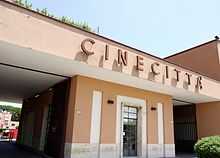Cinecittà


Cinecittà (Italian for Cinema City) is a large film studio in Rome that is considered the hub of Italian cinema.
History
The studios were founded in 1937 by Benito Mussolini, his son Vittorio, and his head of cinema Luigi Freddi for propaganda purposes, under the slogan "Il cinema è l'arma più forte" (Cinema is the most powerful weapon). Mussolini himself inaugurated the studios on April 21st, 1937, which is also the alleged anniversary of the founding of Rome.[1] Post-production units and sets were constructed and heavily used initially. Early films such as Scipio Africanus and The Iron Crown showcased the technological advancement of the studios. Seven thousand people were involved in the filming of the battle scene from Scipio Africanus, and live elephants were brought in as a part of the re-enactment of the Battle of Zama.[2] The studios were bombed by the Western Allies during World War II. Following the war, between 1945 and 1947, the studios of Cinecittà were used as a displaced persons' camp for a period of about two years, following German occupation and a bombing by Allied forces that destroyed parts of the studio.[3] An estimated 3,000 refugees lived there, divided into two camps: an Italian camp housing Italians as well as displaced people from colonized Libya and Dalmatia, and an International camp, where the refugees ranged from Yugoslavia, Poland, Egypt, Iran, and China.[4] Through the immediate post war years, the studios were used once again for their post production facilities as rebuilding had taken form. In the 1950s, Cinecittà was the filming location for several large American film productions like Ben-Hur, and then became the studio most closely associated with Federico Fellini.
After a period of near-bankruptcy in the 1980s, Cinecittà was privatized by the Italian government.
It hosted the 1991 Eurovision Song Contest. The venue had been changed from Sanremo because of security concerns.
Pink Floyd performed, on three consecutive nights, at the studio during The Division Bell Tour on September 19–21, 1994.
On August 9, 2007, a fire destroyed about 3000 m² (32,000 sq. ft.) of the Cinecittà lot and surroundings. The historic part that houses the sets of classics such as Ben-Hur were not damaged, however a good portion of the original sets from the HBO/BBC series Rome were destroyed.[5]
Notable productions
As the home of Italian cinema, Cinecittà has seen the production of many classic films such as La Dolce Vita and Satyricon.
Since the days of Ben-Hur, the studios have welcomed international productions including Helen of Troy (1956), Francis of Assisi (1961), Cleopatra (1963), The Agony and the Ecstasy (1965), Fellini's Casanova (1976), Zeffirelli's Romeo and Juliet (1968), La Traviata (1982) and many other grand film productions. Recent films include Martin Scorsese's Gangs of New York and Wes Anderson's The Life Aquatic with Steve Zissou.
Cinecittà also hosts TV productions, such as Grande Fratello, the Italian version of Big Brother, where the Big Brother house is built on Cinecittà's premises. It has also been home to the filming of The Passion of the Christ, starring James Caviezel and directed by Mel Gibson.
In addition, the BBC/HBO series Rome was filmed there from 2004-2007, the show being widely acclaimed for its sets and designs. BBC Wales reused some of these sets for an episode of the 2008 series of Doctor Who set in ancient Pompeii, and Alexandre Astier reused this set for the Book VI of his television series Kaamelott set in Ancient Rome.
References
- ↑ Bondanella, Peter. Italian Cinema From Neorealism to the Present. The Continuum Publishing Company: New York, NY, 1995.pp.13
- ↑ Bondanella, Peter. Italian Cinema From Neorealism to the Present. The Continuum Publishing Company: New York, NY, 1995.pp.19
- ↑ A documentary, “DP Camp of Cinecittà” by Marco Bertozzi, based on research by Noa Steimatsky, had its world premier on January 30, 2012, at The Italian Cultural Institute of New York, in New York City. (http://www.iicnewyork.esteri.it/IIC_NewYork/)
- ↑ Steimatsky, Noa. The Cinecittà Refugee Camp (1944–1950). October Spring 2009, No. 128: 22–50.
- ↑ "Fire torches film sets at Rome's historic Cinecitta". Canadian Broadcasting Corporation. 2007-08-10. Retrieved 2009-04-25.
External links
- Official website
- Cinecittà on Facebook
- History of Cinecittà
- RAI International:Cinecittà
- Documents Cinecitta'
| Preceded by Vatroslav Lisinski Concert Hall Zagreb |
Eurovision Song Contest Venue 1991 |
Succeeded by Malmö Ice Malmö |
| |||||||||||||||||||||||||||||||||||||||||||||||||||||||||||||||||||||||||||||||||||||||||||||||||
Coordinates: 41°51′N 12°34′E / 41.850°N 12.567°E